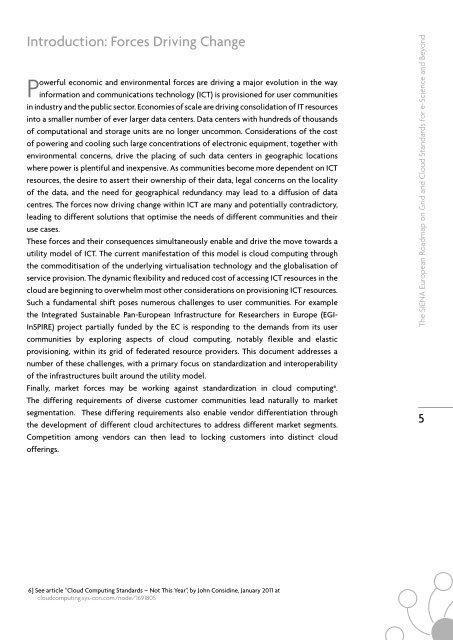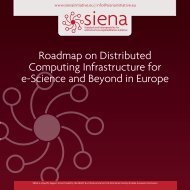SIENA European Roadmap on Grid and Cloud Standards for e-Science and Beyond
SIENA European Roadmap on Grid and Cloud Standards for e ...
SIENA European Roadmap on Grid and Cloud Standards for e ...
Create successful ePaper yourself
Turn your PDF publications into a flip-book with our unique Google optimized e-Paper software.
Introducti<strong>on</strong>: Forces Driving Change<br />
Powerful ec<strong>on</strong>omic <strong>and</strong> envir<strong>on</strong>mental <strong>for</strong>ces are driving a major evoluti<strong>on</strong> in the way<br />
in<strong>for</strong>mati<strong>on</strong> <strong>and</strong> communicati<strong>on</strong>s technology (ICT) is provisi<strong>on</strong>ed <strong>for</strong> user communities<br />
in industry <strong>and</strong> the public sector. Ec<strong>on</strong>omies of scale are driving c<strong>on</strong>solidati<strong>on</strong> of IT resources<br />
into a smaller number of ever larger data centers. Data centers with hundreds of thous<strong>and</strong>s<br />
of computati<strong>on</strong>al <strong>and</strong> storage units are no l<strong>on</strong>ger uncomm<strong>on</strong>. C<strong>on</strong>siderati<strong>on</strong>s of the cost<br />
of powering <strong>and</strong> cooling such large c<strong>on</strong>centrati<strong>on</strong>s of electr<strong>on</strong>ic equipment, together with<br />
envir<strong>on</strong>mental c<strong>on</strong>cerns, drive the placing of such data centers in geographic locati<strong>on</strong>s<br />
where power is plentiful <strong>and</strong> inexpensive. As communities become more dependent <strong>on</strong> ICT<br />
resources, the desire to assert their ownership of their data, legal c<strong>on</strong>cerns <strong>on</strong> the locality<br />
of the data, <strong>and</strong> the need <strong>for</strong> geographical redundancy may lead to a diffusi<strong>on</strong> of data<br />
centres. The <strong>for</strong>ces now driving change within ICT are many <strong>and</strong> potentially c<strong>on</strong>tradictory,<br />
leading to different soluti<strong>on</strong>s that optimise the needs of different communities <strong>and</strong> their<br />
use cases.<br />
These <strong>for</strong>ces <strong>and</strong> their c<strong>on</strong>sequences simultaneously enable <strong>and</strong> drive the move towards a<br />
utility model of ICT. The current manifestati<strong>on</strong> of this model is cloud computing through<br />
the commoditisati<strong>on</strong> of the underlying virtualisati<strong>on</strong> technology <strong>and</strong> the globalisati<strong>on</strong> of<br />
service provisi<strong>on</strong>. The dynamic flexibility <strong>and</strong> reduced cost of accessing ICT resources in the<br />
cloud are beginning to overwhelm most other c<strong>on</strong>siderati<strong>on</strong>s <strong>on</strong> provisi<strong>on</strong>ing ICT resources.<br />
Such a fundamental shift poses numerous challenges to user communities. For example<br />
the Integrated Sustainable Pan-<str<strong>on</strong>g>European</str<strong>on</strong>g> Infrastructure <strong>for</strong> Researchers in Europe (EGI-<br />
InSPIRE) project partially funded by the EC is resp<strong>on</strong>ding to the dem<strong>and</strong>s from its user<br />
communities by exploring aspects of cloud computing, notably flexible <strong>and</strong> elastic<br />
provisi<strong>on</strong>ing, within its grid of federated resource providers. This document addresses a<br />
number of these challenges, with a primary focus <strong>on</strong> st<strong>and</strong>ardizati<strong>on</strong> <strong>and</strong> interoperability<br />
of the infrastructures built around the utility model.<br />
Finally, market <strong>for</strong>ces may be working against st<strong>and</strong>ardizati<strong>on</strong> in cloud computing 6 .<br />
The differing requirements of diverse customer communities lead naturally to market<br />
segmentati<strong>on</strong>. These differing requirements also enable vendor differentiati<strong>on</strong> through<br />
the development of different cloud architectures to address different market segments.<br />
Competiti<strong>on</strong> am<strong>on</strong>g vendors can then lead to locking customers into distinct cloud<br />
offerings.<br />
The <str<strong>on</strong>g>SIENA</str<strong>on</strong>g> <str<strong>on</strong>g>European</str<strong>on</strong>g> <str<strong>on</strong>g>Roadmap</str<strong>on</strong>g> <strong>on</strong> <strong>Grid</strong> <strong>and</strong> <strong>Cloud</strong> St<strong>and</strong>ards <strong>for</strong> e-<strong>Science</strong> <strong>and</strong> Bey<strong>on</strong>d<br />
5<br />
6] See article “<strong>Cloud</strong> Computing St<strong>and</strong>ards – Not This Year”, by John C<strong>on</strong>sidine, January 2011 at<br />
cloudcomputing.sys-c<strong>on</strong>.com/node/1691805



